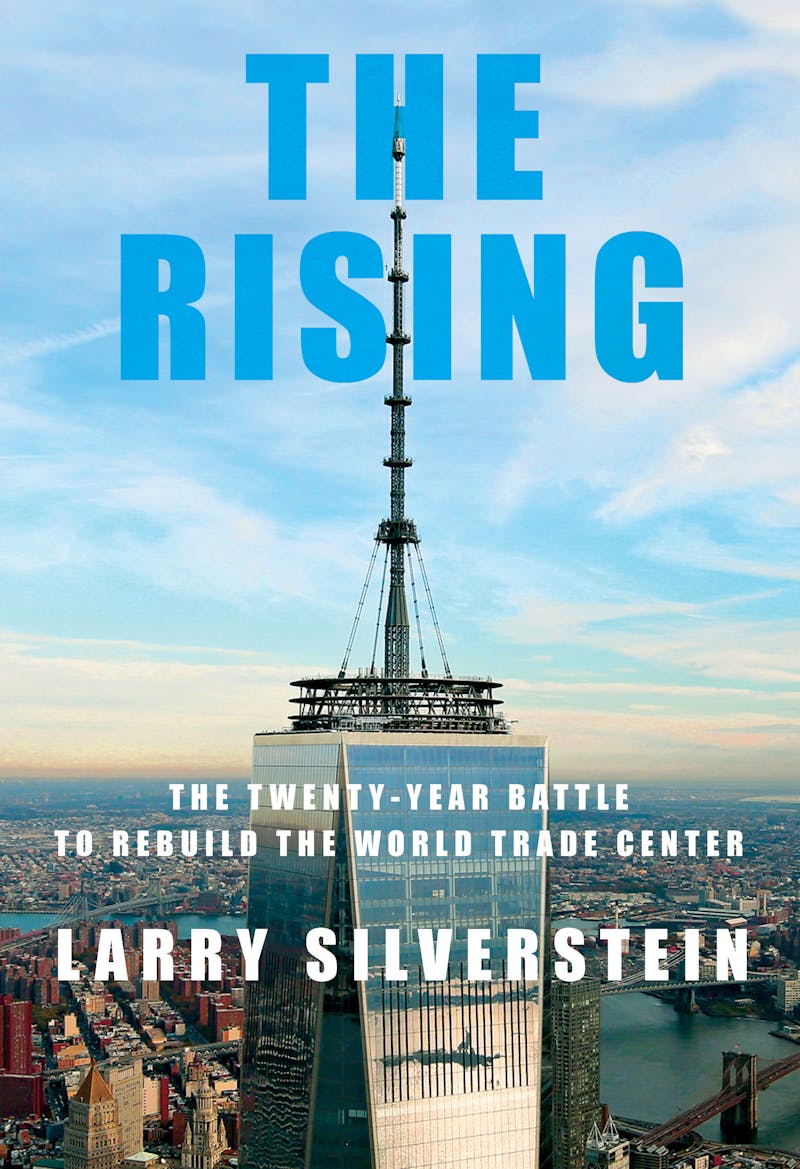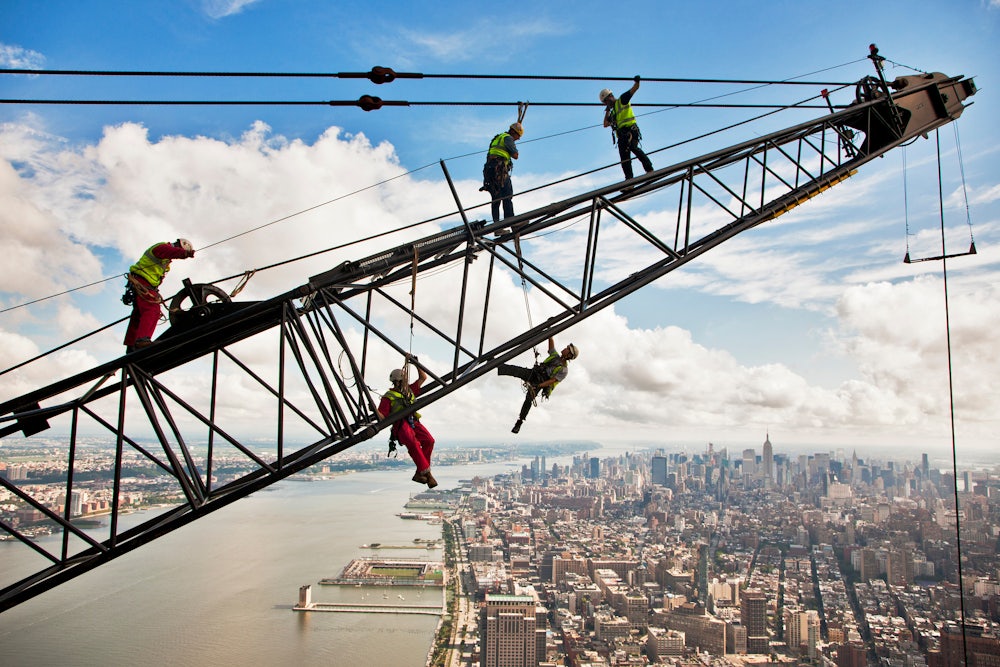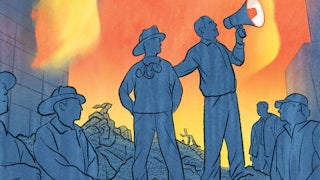The year 2001 was a bad one for Larry Silverstein, the New York real estate developer. First, he got hit by a car. In the true fashion of a Manhattan real estate boss, he was coming back from a celebratory dinner at Le Cirque carrying a jeroboam of wine when someone ran a red light, smashing into him and breaking his pelvis in 12 places. His recovery was certainly improved by the news that the preferred bidder on the World Trade Center property had dropped out due to problems with the Port Authority (the owner of the site) and Silverstein would be taking on the 99-year lease for $3.2 billion. Unfortunately, that moment of triumph was in July 2001.
By this point in his career, Silverstein was already 70 years old and had recently purchased a 180-foot boat with a pool, gym, and elevator. Yet, as he makes clear in his memoir, The Rising: The Twenty-Year Battle to Rebuild the World Trade Center, he is not the kind of billionaire who wants to sail off into the sunset with a daiquiri in hand. This was why, when terrorists smashed two planes into the Trade Centers, killing almost 3,000 people and throwing the future of Lower Manhattan as a financial center into question, he chose not to simply take a check for his losses (he was offered the full amount along with compensation for his time). His reflection on this—which he relayed immediately to then-Governor George Pataki—is written with the typical brevity and bombast of the book: “We need to rebuild. There’s no doubt in my mind.… We—Americans, New Yorkers—could not allow the terrorists to triumph.”

Silverstein does not think too much about the complaints of family members whose loved ones’ remains are still on the site (many bodies were not recovered and were ‘vaporized’ into the rubble) or those who said that replacing the commercial uses would be inappropriate and the entire area would be better as a park. No, he did not become the owner of the world’s largest office building through self-doubt or emotional attachment to empty lots, he plainly states: “We can’t let the site remain a pit. We have to rebuild, or else they will have won.” The only possible solution was to restore the 10 million square feet of office space to Lower Manhattan, or else America would live in perpetual shame.
If Silverstein’s idea of patriotism sounds a lot like George W. Bush’s exhortation to “go shopping” after 9/11, that is because they both come from the same era of naïve patriotism. Silverstein relished the challenges—engineering, financing, architecture, and political wrangling—of redeveloping the WTC site. Written in the short punchy sentences favored by get-things-done Manhattan moguls, The Rising does not pause to reflect on what the site could have been and what rebuilding could have meant to New York as a whole and to a broader range of New Yorkers than this first-person narrator. It might have served as a forested park with 3,000 trees to commemorate the dead and to suck carbon out of the overheated streets of Lower Manhattan, or it could have been a new neighborhood with housing and schools like nearby Battery Park City. Was office space what the city most needed? Even as early as 2001, financial firms began to move to Connecticut and New Jersey to take advantage of tax deals and larger office spaces. More importantly, many firms were still skittish about creating identifiable landmark towers where a terrorist attack had taken place, and law enforcement required expensive building modifications like One World Trade’s meter-thick blast-resistant concrete core.
Silverstein does not ponder noncommercial uses for the huge chunk of land. His hackneyed life philosophies are far simpler: “I am a very tenacious guy. When I start something, I am determined to finish it.” However, he does have a point: There were far easier ways to make money in the early 2000s than fighting with New York politicians, insurance companies, and architects to build on one of the world’s most emotive, highly used, and structurally complex pieces of land.
Silverstein Properties had been, by Larry Silverstein’s account, an unlikely company to take control of the World Trade Center: two megatowers with their own zip code in Lower Manhattan. His privately held family firm was big but nothing like some of his giant, publicly traded competitors. In his estimation it all boiled down to his ability to be the Port Authority “whisperer”—a skill he developed when he was chosen to build 7 World Trade Center in 1984. Silverstein found he was able to accept delays, intricate bureaucratic processes, and nonstandard contracts in ways that larger firms would not.
The Port Authority, begun in 1921, is a partnership between New York state and New Jersey, owning multiple transportation systems and properties, and self-funded through tolls. Although never actually under the supervision of Robert Moses (the infamous planning czar of New York, who loomed large over the middle of the century), it embodies his thinking of centralized technocratic power that moves across state lines and seeks to supersede politicians by maintaining its own treasury. Developers found dealing with this system challenging, hence Silverstein’s advantage when a larger firm dropped out of the bidding for the World Trade Center in exasperation.
Silverstein’s odyssey to rebuild after 9/11 started with a poisoned relationship with Rudolph Giuliani, who consistently vilified him in the tabloids. Silverstein was eventually able to collect insurance money from 25 recalcitrant lenders and to convince political officials that the WTC site needed the building that at first was known as the Freedom Tower, as well as a memorial and several more office towers. Silverstein was never a fan of the design of the original World Trade Centers; he more or less agreed they looked like glass and steel shoeboxes. He wanted to see a range of compellingly designed towers built in their place. He appreciated One World Trade’s design by Daniel Libeskind, the starchitect who made the Berlin Jewish Museum, but he found him to be an insufferable prima donna who was completely out of his depth when it came to project management. Silverstein prefers corporate architects with experience building massive structures, thus he speaks glowingly of David Childs of Skidmore, Owings, and Merrill (the preeminent behemoth architecture firm in the world), who eventually replaced Libeskind when Libeskind irritated too many important people. Silverstein also assembled a slate of Pritzker Prize–winners to complete his other office buildings on the WTC site: Fumihiko Maki for Building Four, Richard Rogers for Building Three, and Norman Foster for Building Two. Despite the big names, they are all typical Manhattan office slabs you probably would not look twice at if they were not standing next to the Michael Arad–designed memorial: two open chasms filled with water on the exact footprints of the former Twin Towers.
The exasperation felt by Silverstein toward the Port Authority is, on one hand, the crocodile tears of a developer Goliath pretending to be a David, but he also deserves some sympathy. He constantly had to work with people who would not stick to plans or a timeline while he also continued to pay a monthly installment of $10 million in ground rent. He had to witness the colossal mismanagement of the Oculus transit hub, designed by Santiago Calatrava, which eventually cost $4 billion. At the same time, Silverstein has always received the goodies of the corporate welfare built into public-private development ventures: He took advantage of the Payment in Lieu of Taxes, or PILOT, agreement started in 1973 that saved him approximately 75 percent in annual tax bills; the city used eminent domain to switch his ownership of Greenwich Street to Vesey Street to make his plans work; and he received $2.6 billion in tax-free bonds for constructing the post-2001 WTC. So when Silverstein rails against the inefficiency of the public sector, it is mostly the process that galls him and not the deep pockets, planning authority, or tax abatement.
For over 20 years, Silverstein has been pilloried in the press as the characteristic rapacious developer willing to do anything for a buck (even worse, 4chan-style blogs tied him to antisemitic conspiracy theories that no Jews showed up to work on September 11, 2001). He complains: “They never appreciated my deep patriotic and civic commitment to rebuilding the site. Sure, I am a businessman.… But that was far from the energizing motive in my setting out to bring the World Trade Center complex back to life.” And he is right: No one would have put up with the stress of this endeavor without commitment beyond their wallet, particularly not at post-retirement age, as Silverstein was when it all started. At the same time, the “rejuvenation” of Lower Manhattan is very much the work of real estate developers who only see office buildings when they look at plots of land, despite diminishing need for this use. Indeed, finding tenants for One World Trade has been vexing. Eventually Condé Nast was coaxed down from midtown and several government agencies took space.
The rebuilding of the WTC site was mired in the ideas of mid-twentieth century urbanism: big name architects, soaring glass towers, and business districts neatly separated from where people live, raise families, and entertain themselves. Those ideas no longer function in 2024. Silverstein barely mentions the Perelman Performing Arts Center, which opened on the WTC site in 2023, because it is not rentable land. A bigger problem for the arts center is that it attempts to add life to a precinct where no one lives. If Silverstein and other movers and shakers truly wanted to demonstrate the phoenix-like potential of Lower Manhattan, they should have added residents, not just office workers, to the massive plot of land they restored. The only time the neighborhood felt like a place with a beating heart past sundown was during Occupy Wall Street, and that was probably not what Larry Silverstein had in mind for activating the WTC precinct.
The failure of imagination for the WTC site is intertwined with two larger problems. One is the housing crisis and questions of why the redeveloped plot did not include mixed-use commercial and residential: If it was appropriate to have offices on top of the remains of several thousand New Yorkers then surely apartments would also be viable? Second, the office building sector is facing an existential crisis due to remote work and dispersed employees. Starting before Covid-19 and accelerating rapidly after 2020, the expensive, imposing Manhattan office tower is starting to look like a relic of the past and an urban planning problem necessitating expensive adaptive reuse plans. The billions of dollars spent on recreating the WTC look in retrospect expensive, hubristic, and ultimately pointless. Silverstein succeeded in getting the Manhattan of the past rebuilt, but, in all likelihood, the New York of the future will look quite different.






